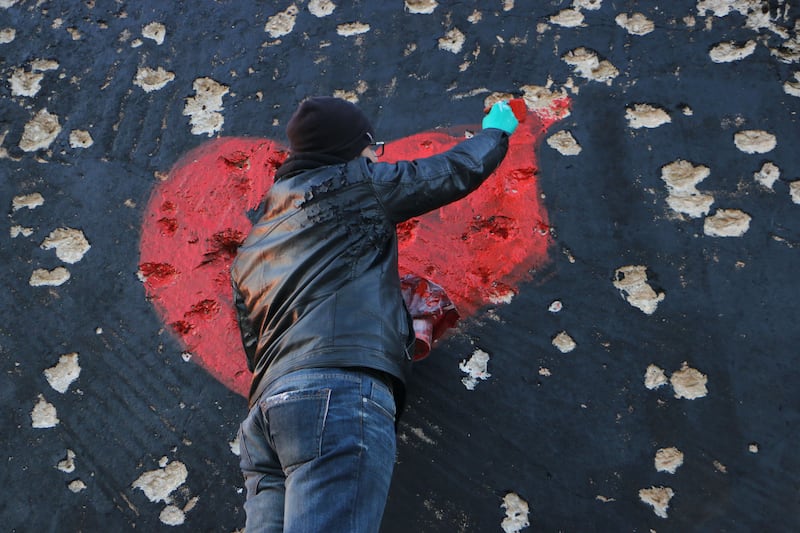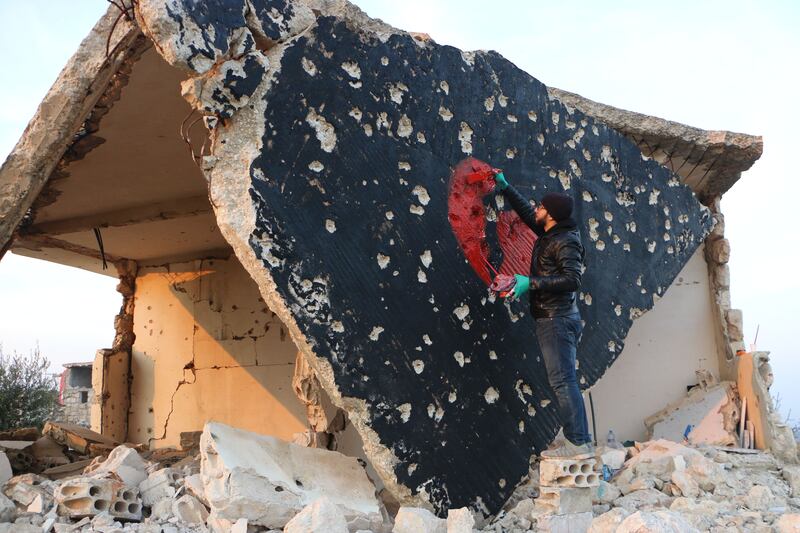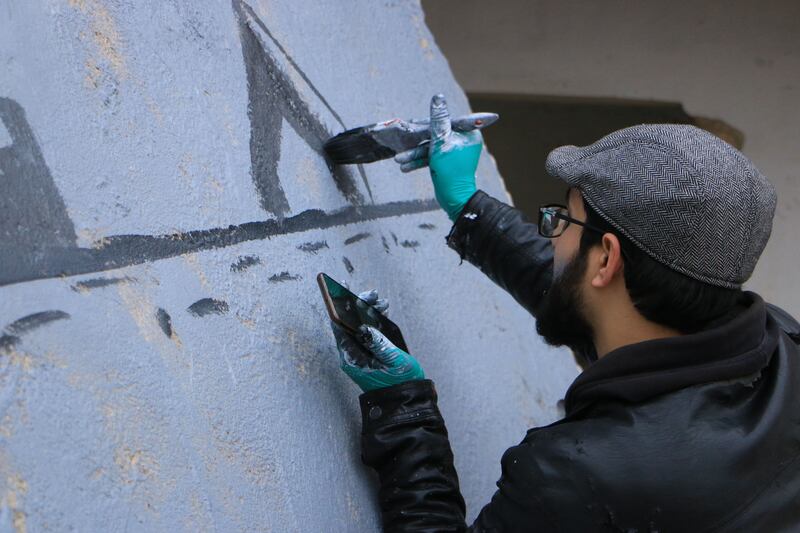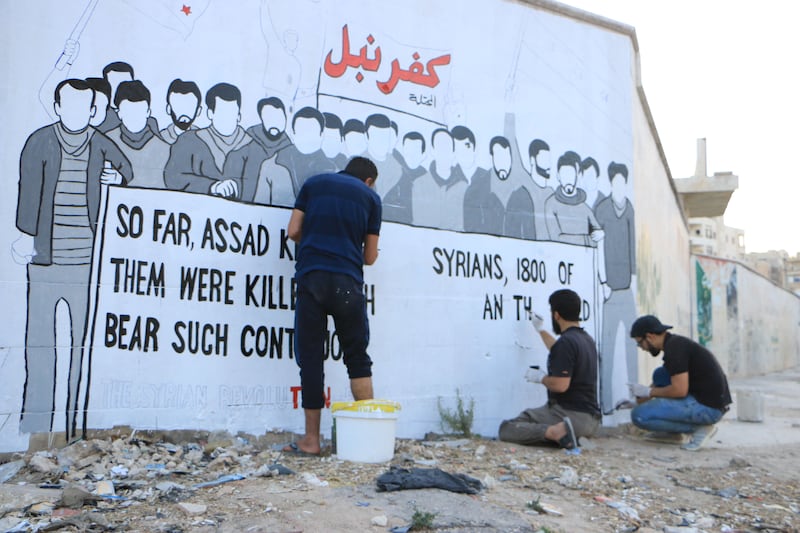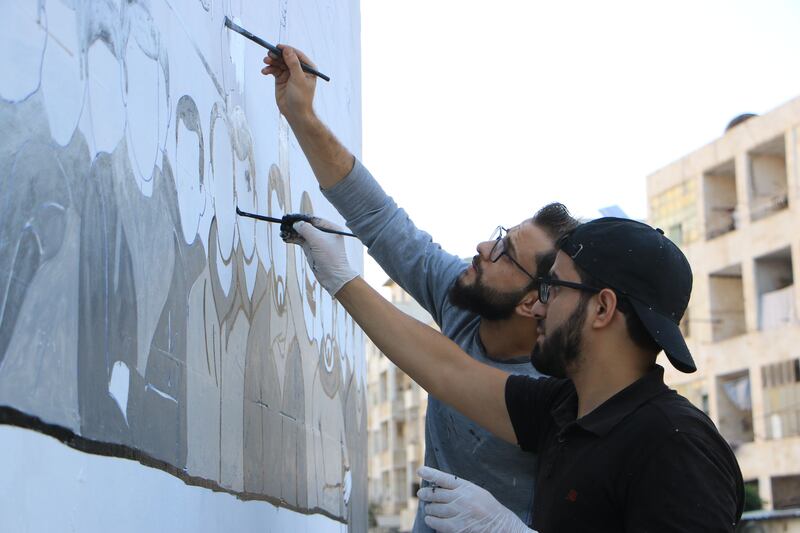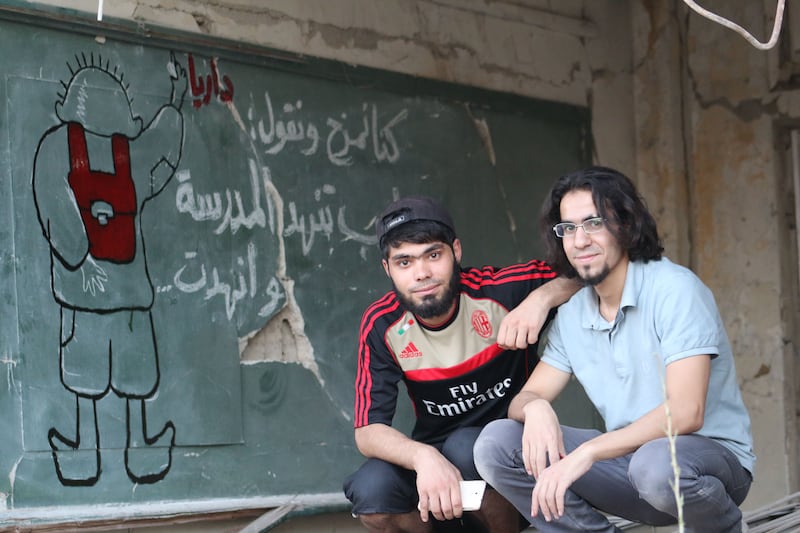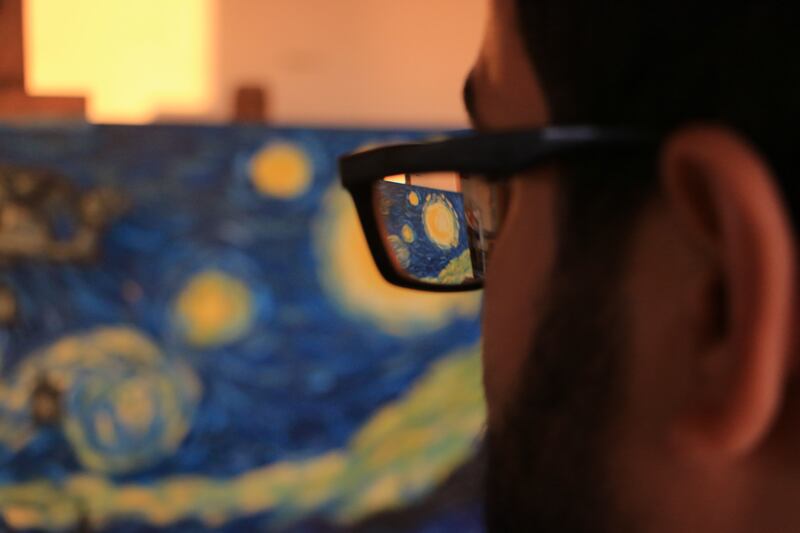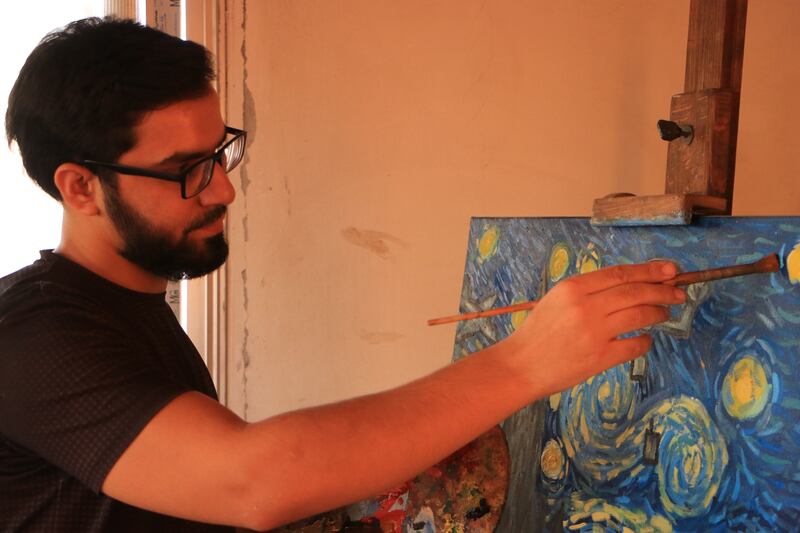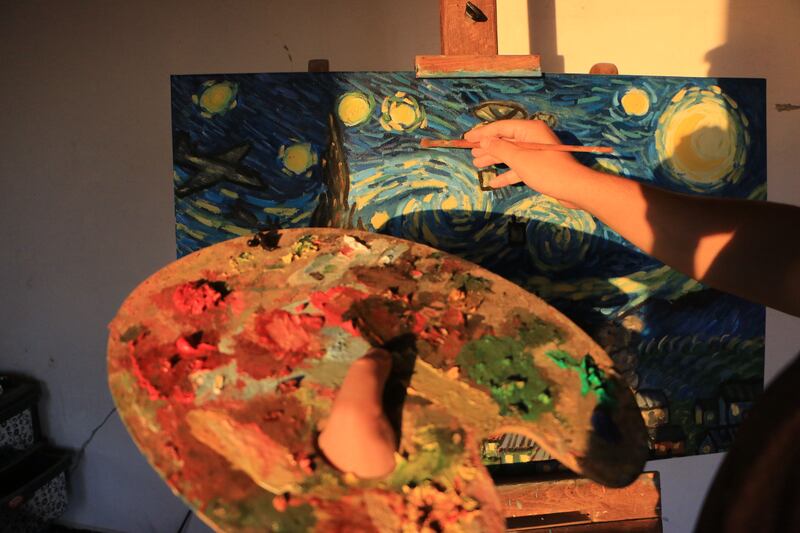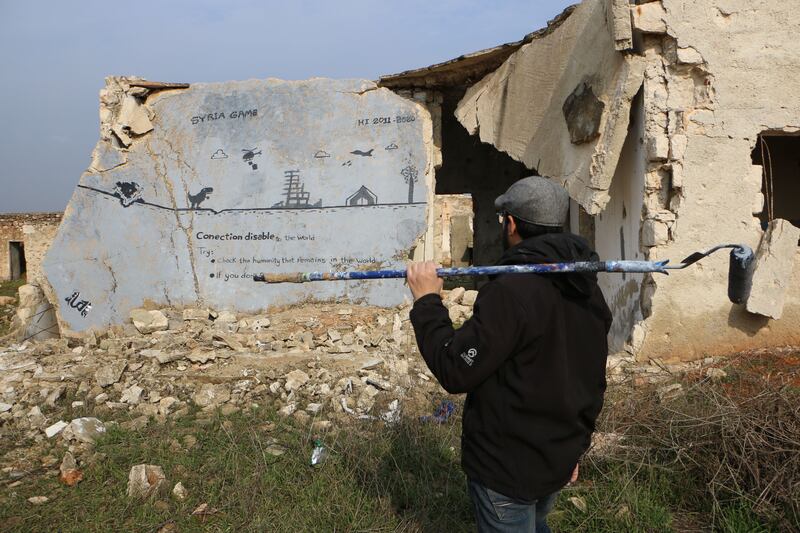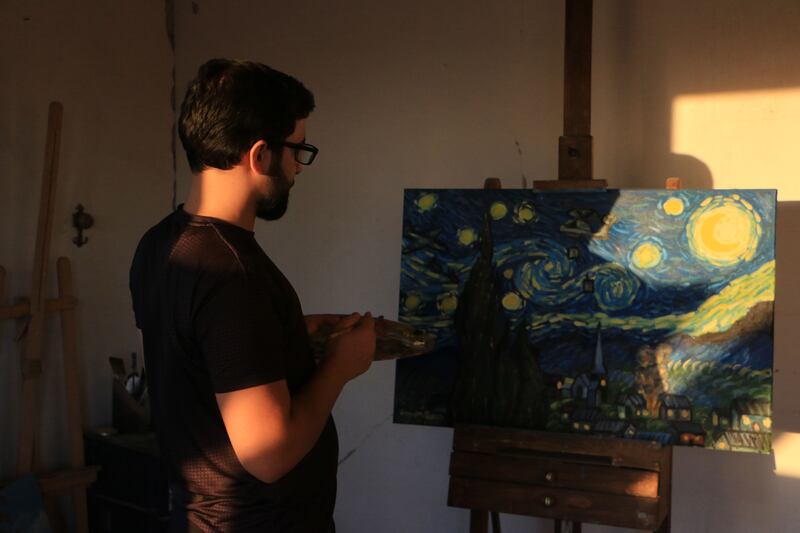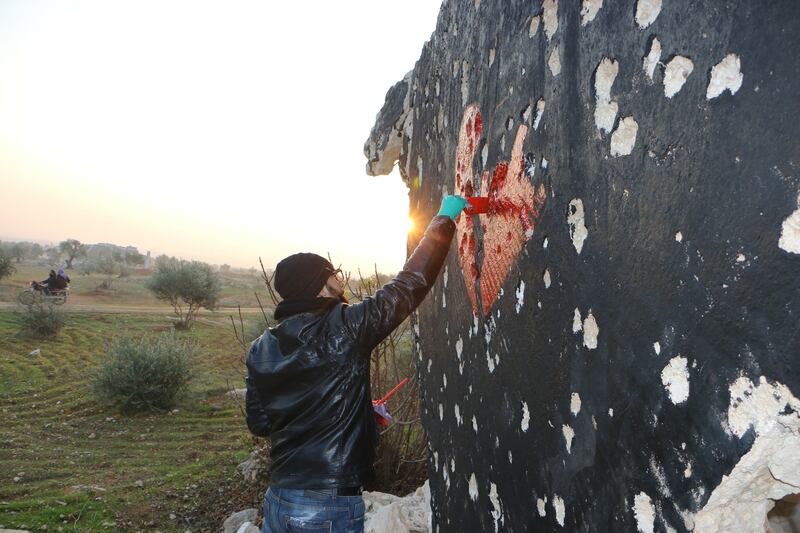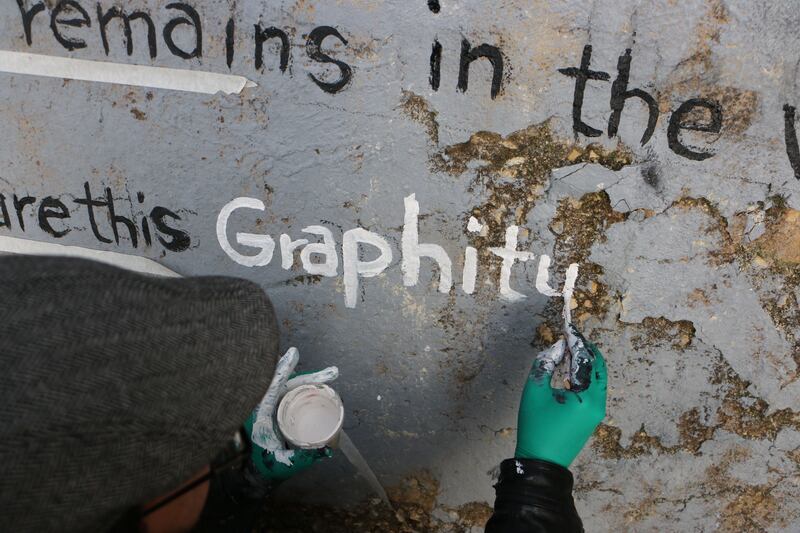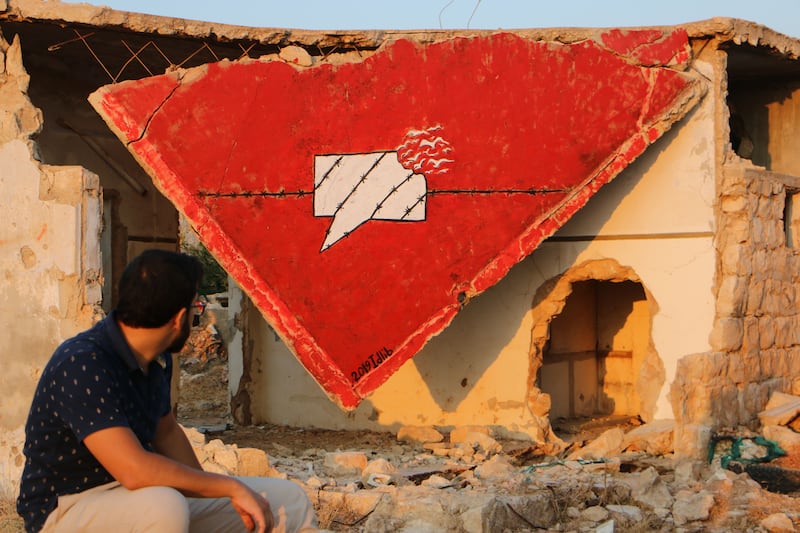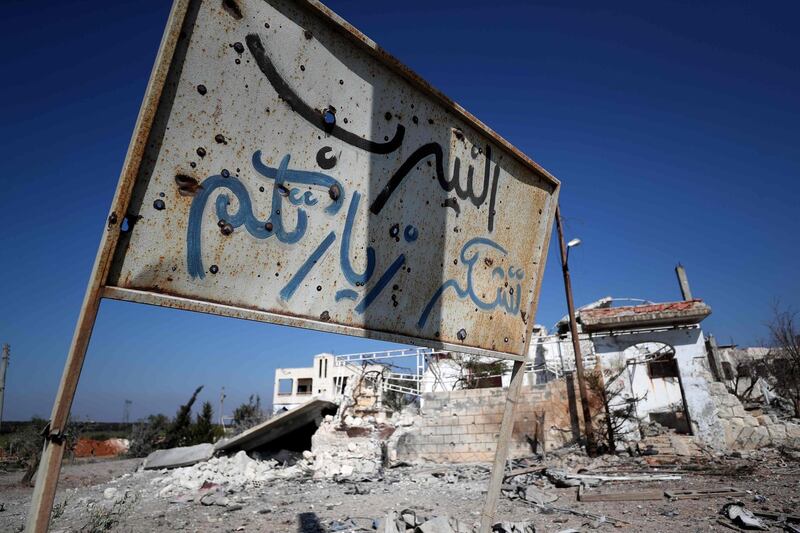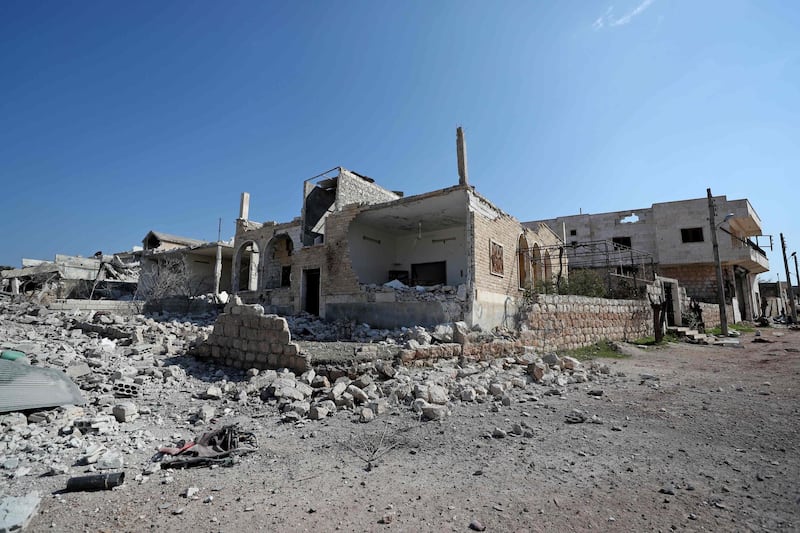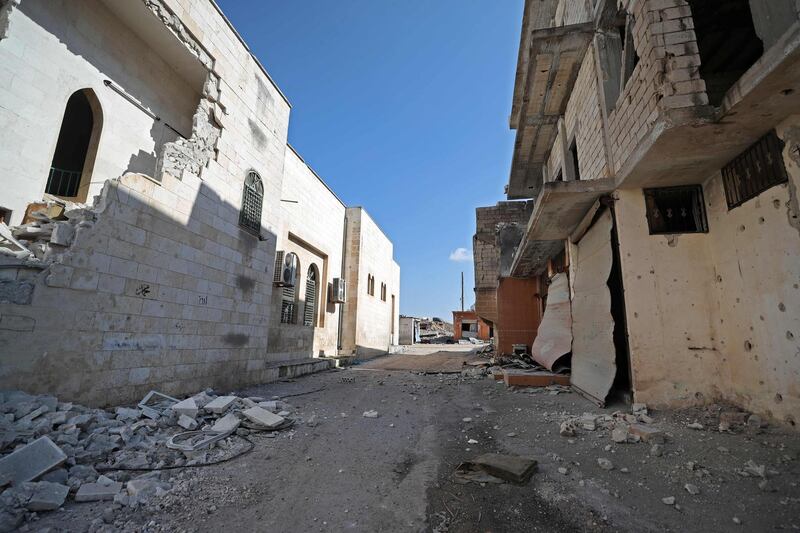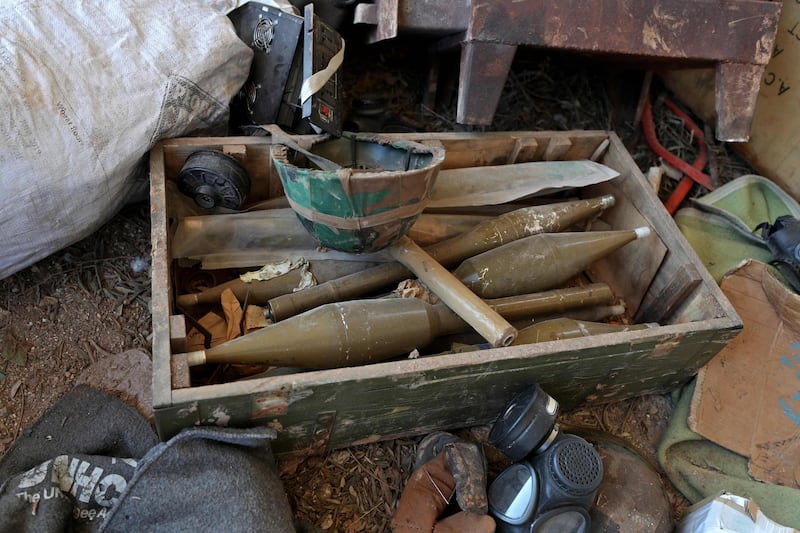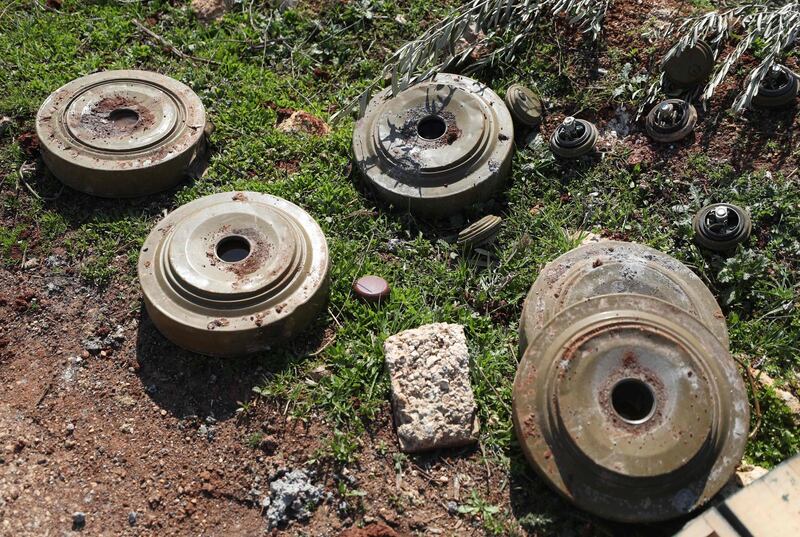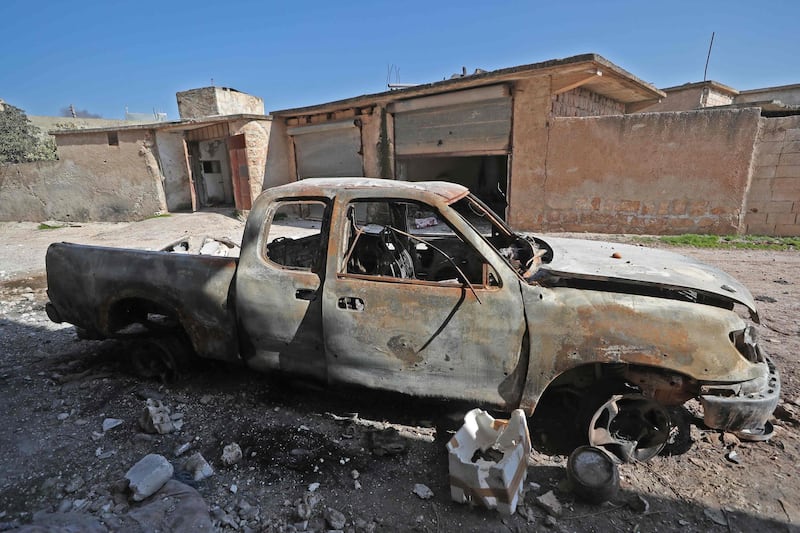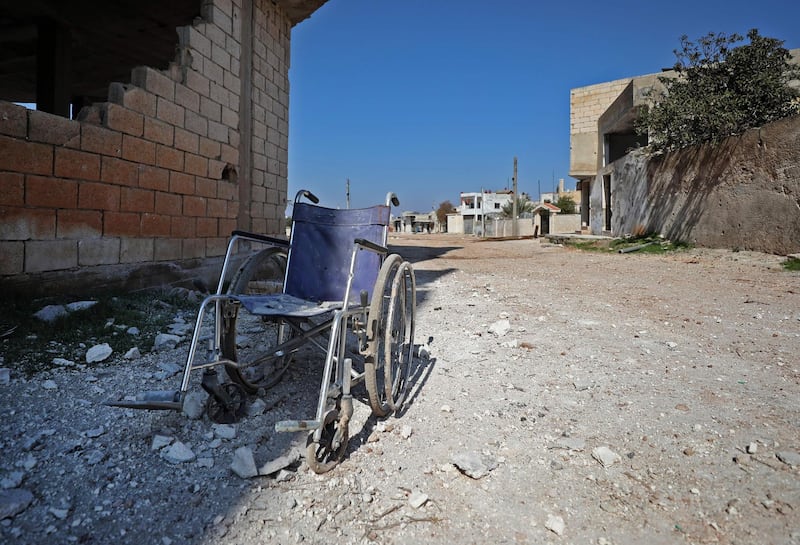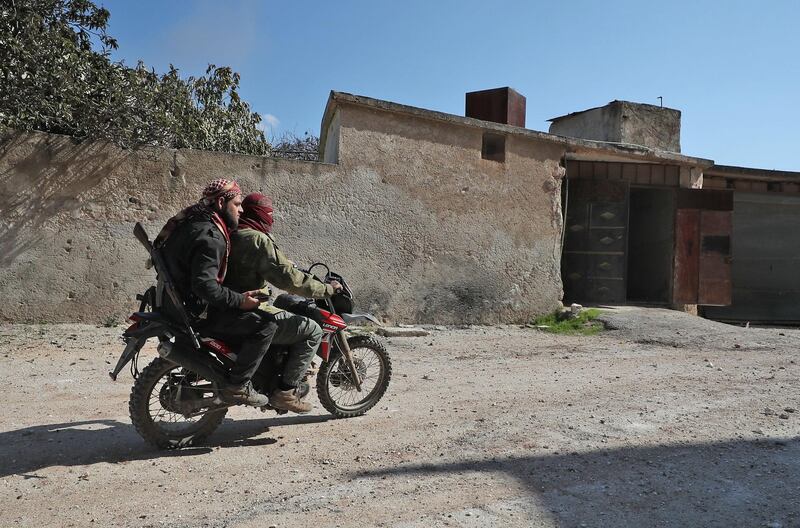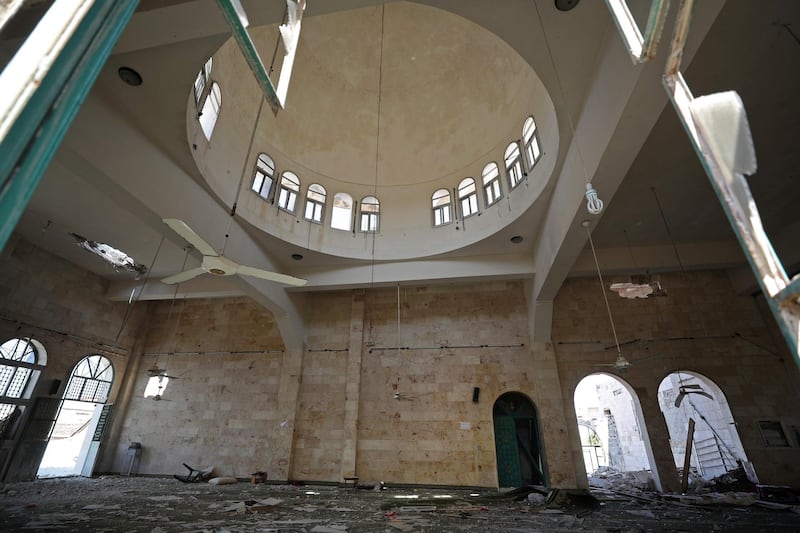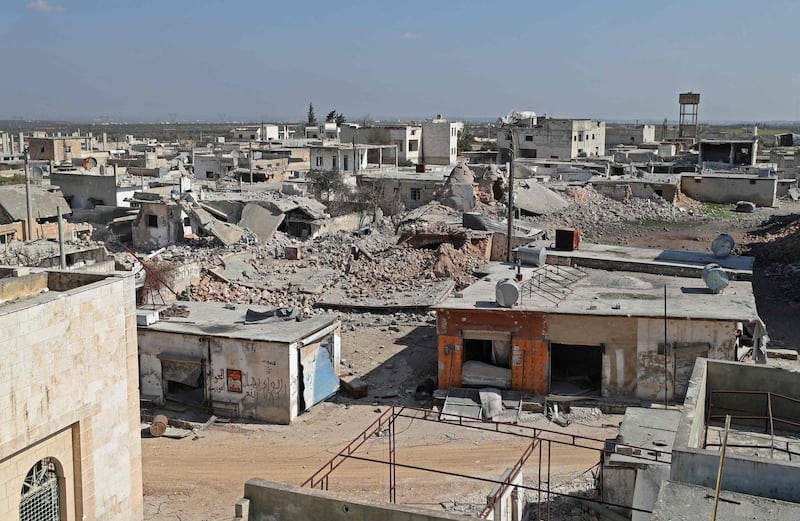Abu Malek Al Shami stands on a mound of rubble, remnants of a bombed-out building in war-shattered Idlib, gazing at his artwork on a collapsed concrete slab.
The silhouette of a young man, his head down and carrying a small bag of possessions tied to a stick, walks through an empty landscape.
Hands stretch up from the ground, as if to pull him back. Are they beckoning him to join them in death? Do they represent a longing to return to a place of displacement?
Al Shami says this poignant image mirrors the condition of a generation of young Syrians who found themselves on the receiving end of a regime determined to destroy any sign of opposition by any means possible, no matter how brutal.
He, too, is a member of this lost generation, but has been hailed as “Syria's Banksy”, after the internationally renowned graffiti artist. Like Banksy, he has become known for his striking, colourful murals – only in Al Shami's case, they are on the walls of ruined Syrian cities at the height of the conflict.
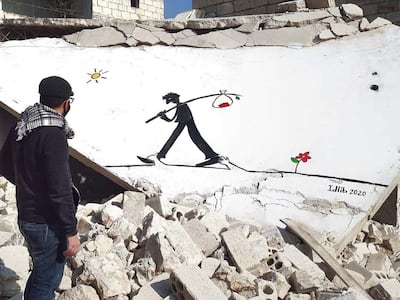
As state repression became more extreme, he was forced to join nearly four million Syrians in the crowded, war-scarred governorate of Idlib, a place that faces periodic heavy bombing between lulls in violence.
“After I was displaced from Daraya, a suburb of Damascus, in 2016, I paused the art to put all my efforts into finding a new residence, but all of my attempts were in vain. I’m still looking for myself, for a suitable opportunity to learn, for a good job and for the art that is lying inside me,” he tells The National.
The beginnings
Al Shami was born in Damascus in 1994, the ninth brother among 11 siblings. Since childhood, he has had a passion for drawing.
During the first demonstrations at the start of 2011, Al Shami joined crowds of protesters in the Kafar Sousah neighbourhood in Damascus, writing banners and drawing political pictures for anti-regime marches.
It was there that he realised “art’s power to unite people and deliver the revolutionaries’ message to the world,” he says.
Graffiti was not known in Syria before the revolution. However, it developed when children in the southern city of Daraa wrote on walls: “Now it’s your turn, doctor!” – a message to President Bashar Al Assad, who trained as an ophthalmologist, after uprisings across the region in 2011 which toppled leaders in Egypt and Tunisia.
These early expressions soon evolved into political street art.
By the end of 2012, Syria was in the grip of a bloody civil war. Many of Al Shami's brothers were arrested and he feared he would be next. He stopped his studies and left Damascus.
The ruins of revolution
By early 2013, Al Shami found himself in Daraya, a place he visited for “adventure”, he says. The security services were soon breaking into homes and arresting people who were involved in peaceful demonstrations. “I realised it was a matter of time before I got arrested“, he says.
He was astonished by the situation in the town and the scale of the destruction.
“Most of the people there were university students. I thought I would get killed because the conflict was so one-sided,” he says.
The Syrian regime dropped hundreds of barrel bombs on the suburb amid artillery barrages, destroying and damaging thousands of homes.
“Every day, many of our friends die. The grim life in the town became routine. So, I began practising my hobby of drawing. I drew on the walls of my room.”
At that time, Al Shami met Majd Mohadamani, a journalist who was documenting the war in Daraya. When he saw Al Shami’s drawings, he suggested he should paint on the destroyed walls in the streets.
“I was excited about the idea. It was the first time for me to paint graffiti, it was a big challenge for me to achieve."
The two men chose the roofs of ruined buildings for their work.
Mohadamani, originally from Daraya, provided the painting materials and picked the locations, but Al Shami had many fears.
“I was afraid of people's views, those who considered this work to be trivial and a waste of time, or that drawing on their destroyed houses would annoy them.”
The first mural was designed by a Syrian artist known as Omran and painted in July 2014. Called Learn to Love First, it shows a small girl is facing a soldier holding a rifle on his back.
Al Shami says he coloured the artwork so that the soldier could not be identified with any armed group. Instead the work was directed at all the fighters in the country.
“The child is trying to teach him a simple lesson, pointing to the picture of a heart so that he may ask why, and for whom, he is fighting."
In the last period of the siege of Daraya, Mohadamani was killed while covering the fighting and Al Shami's lungs were injured, which forced him to suspend work for a long period.
“One day before Mohadamani died, he recommended I should continue the work despite what would happen. The news of his death was very shocking."
Al Shami fled to Idlib in 2016, leaving behind 30 works of art. “Our murals made an artistic and cultural impression after we left,” he says.
In Idlib, he met an artist who taught him to create oil paintings as a substitute for graffiti.
But he soon faced new problems. “I thought I could practise my activity freely with the availability of equipment. However, the involvement of armed groups in civil issues distracted me from my work, requiring that my artwork would support their interest, or be under their control.”
Since 2017, Idlib has been under the control of Hayat Tahrir Al Sham, an umbrella group of militias, at least one of which is linked to Al Qaeda’s Syrian branch.
The rise of militant groups and the siege-like conditions in Idlib made it difficult for Al Shami to work – in addition to working in secrecy, the rising cost of materials and the absence of a sponsor who could help him continue his art freely.
Despite this, he has co-operated with several organisations, including the Ema’a Foundation NGO for one year, during which he drew three murals.
He also worked with an art collective based in Kafranbel, a town that became known for colourful and innovative protest banners and anti-regime artwork, until it was retaken by Assad’s forces in early 2020, as well as working with Sketch for Syria, a local art campaign which envisages the country post-conflict.
But surviving in Idlib has been the toughest challenge. With limited materials, much of his artwork is completed on fabric or wood.
“I made 13 paintings in 2019 and 17 paintings in 2020 despite the fact that I had to flee during that year. It is true that I suffered from a lack of materials and colours and the lack of required equipment, but I was used to using whatever I can find.”
One of his paintings is based on Vincent van Gogh's iconic The Starry Night, with a Syrian-conflict twist – a helicopter poised to drop a barrel bomb.
“If Vincent van Gogh lived in Syria, he wouldn’t see the beauty of the sky, the moon, the stars and nature because of air strikes that destroyed everything. We in Syria are living a very gloomy story. Everyone is watching but no one is doing anything,” he says.
'Art may lose its moral impact'
Despite Al Shami’s travails, the artist understands that a lack of materials and funding are problems shared by millions of other artists around the world.
Without external support, art will lose its moral impact, he warns, and become purely a commercial venture where artists create simply to survive.
The graphic design nature of what he does could lend itself not to self-expression, but commerce.
“Artists involved in graffiti will decrease in number and their work will become limited to advertisements," he says.
In the early months of 2021, he created 20 paintings, against the odds.
“I cannot stabilise, I am facing difficulty in an environment where we're facing bloody events daily, with no space for art," he laments.
“I am trying to leave Syria. I am afraid to be a number among the dead and injured in a war which has Idlib as its last destination. Maybe I could survive with what’s left of my art and thoughts, and go to a place where I can resume the struggle again."
